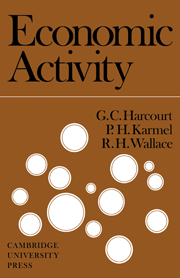Book contents
- Frontmatter
- Preface
- Contents
- 1 INTRODUCTION
- 2 THE NATIONAL ACCOUNTS AND THE INCOME–CREATION PROCESS
- 3 THE PRODUCTION–INCOME–EXPENDITURE CIRCUIT AND NATIONAL ACCOUNTING IDENTITIES
- 4 THE DETERMINATION OF THE EQUILIBRIUM LEVEL OF REAL INCOME
- 5 THE CONCEPT OF FULL EMPLOYMENT
- 6 MONEY IN THE ECONOMIC PROCESS
- 7 THE BANKING SYSTEM AND THE QUANTITY OF MONEY
- 8 THE CONSUMPTION FUNCTION
- 9 THE DETERMINANTS OF INVESTMENT EXPENDITURE
- 10 THE EFFECT OF CHANGES IN EXPENDITURE PLANS: THE MULTIPLIER CONCEPT
- 11 THE GOVERNMENT SECTOR AND THE DETERMINATION OF REAL INCOME
- 12 THE OPEN ECONOMY
- 13 THE INTERACTION BETWEEN PLANNED EXPENDITURES AND FINANCIAL FACTORS
- 14 INFLATION
- 15 ECONOMIC POLICY
- List of suggested reading
- Index
4 - THE DETERMINATION OF THE EQUILIBRIUM LEVEL OF REAL INCOME
Published online by Cambridge University Press: 18 December 2009
- Frontmatter
- Preface
- Contents
- 1 INTRODUCTION
- 2 THE NATIONAL ACCOUNTS AND THE INCOME–CREATION PROCESS
- 3 THE PRODUCTION–INCOME–EXPENDITURE CIRCUIT AND NATIONAL ACCOUNTING IDENTITIES
- 4 THE DETERMINATION OF THE EQUILIBRIUM LEVEL OF REAL INCOME
- 5 THE CONCEPT OF FULL EMPLOYMENT
- 6 MONEY IN THE ECONOMIC PROCESS
- 7 THE BANKING SYSTEM AND THE QUANTITY OF MONEY
- 8 THE CONSUMPTION FUNCTION
- 9 THE DETERMINANTS OF INVESTMENT EXPENDITURE
- 10 THE EFFECT OF CHANGES IN EXPENDITURE PLANS: THE MULTIPLIER CONCEPT
- 11 THE GOVERNMENT SECTOR AND THE DETERMINATION OF REAL INCOME
- 12 THE OPEN ECONOMY
- 13 THE INTERACTION BETWEEN PLANNED EXPENDITURES AND FINANCIAL FACTORS
- 14 INFLATION
- 15 ECONOMIC POLICY
- List of suggested reading
- Index
Summary
Introduction
Study of the national accounts is useful in itself; it enables the complex relationships involved in a modern economy to be examined within an orderly framework. The information published in the Australian National Accounts shows in considerable detail how resources are allocated between alternative uses and how income is divided among broad groups in the community.
This information is a prerequisite for economic planning and policy-making. Is the rate of economic growth adequate? Is the income share of wage- and salary-earners changing? How important is the wool industry in the economy? What would be the effect on the availability of goods and services for other uses if defence expenditure were doubled? What will be the economic effects of the increased home construction associated with the anticipated marriage boom of the late 1960s? Is the Australian economy as dependent on export sales now as it was a decade ago?—these are but a small sample of the questions for which the national accounts provide a factual basis (although not a complete one) for rational discussion.
The particular use to which the national accounting framework is applied in this book is for the analysis of the determination of the short-run level of economic activity. In the discussion of national accounting it was shown that aggregate economic activity can be viewed from three aspects—production, income and expenditure.
- Type
- Chapter
- Information
- Economic Activity , pp. 40 - 61Publisher: Cambridge University PressPrint publication year: 1967



